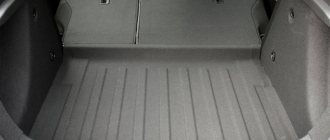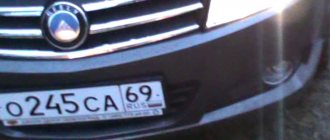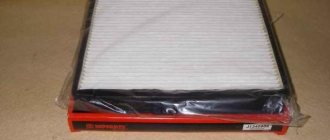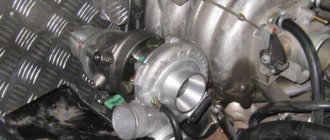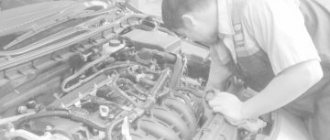The ground clearance of the Chevrolet Lacetti is selected in such a way as to ensure sufficient cross-country ability while maintaining good handling throughout the vehicle's entire speed range. In domestic realities, the clearance provided by the factory is often insufficient.
The car gets hit on the bottom when overcoming road obstacles, catches on curbs while parking, and gets stuck in the snow. For these reasons, car owners resort to increasing ground clearance using various methods.
Increased ground clearance of Chevrolet Lacetti
Clearance dimensions for the Chevrolet Lacetti
The clearance of the Chevrolet Lacetti is directly related to the vehicle load and the location where the distance is measured. The official data that the automaker provides in the manual is presented in the table below.
| Model | Ground clearance size, mm |
| Chevrolet Lacetti 2004, hatchback | 145 |
| Chevrolet Lacetti 2004, station wagon | 145 |
| Chevrolet Lacetti 2004, sedan | 145 |
The car's suspension is rigid, so the actual ground clearance rarely differs from the official data. A decrease in ground clearance can only be noticed in vehicles in poor technical condition. With a “broken” suspension, ground clearance may decrease by 20-30 mm.
Maximum trunk dimensions
If you fold the rear seats, the luggage compartment measures 1,720 mm in length.
The maximum length that can be accommodated in a Lacetti with the rear and front seats folded is 2,600 mm ! This is the distance to the car's dashboard. But some manage to transport things 3 meters (3,000 mm) by placing them on the dashboard, at the bottom of the windshield.
Also, about the general overall dimensions of the Lacetti, read below
Increasing the ground clearance of the Chevrolet Lacetti without major design changes
The easiest way to increase ground clearance is to use wheels with a larger diameter than the standard ones. This method allows you to raise the car up to 15 mm. In this case, returning to the standard ground clearance is not difficult; it is enough to return the old wheels to their place. This method is not without its drawbacks. The main ones are:
- false measurement of the distance traveled by the odometer;
- bumps and wheel jams when driving over obstacles on the road, such as speed bumps;
- incorrect speed measurement by the speedometer, which can lead to a fine;
- deterioration in handling, which is most noticeable when entering a turn or at high speed;
- inability to move the vehicle when fully loaded due to wheel jamming;
- the need to change wheels to standard ones when passing a technical inspection;
- The maximum increase in ground clearance is limited to 15 mm.
Transmission
All Lacetti station wagon configurations are presented with two types of gearboxes: manual and automatic to choose from. The most reliable and durable is considered to be the 5-speed classic manual transmission layout of the German design, which is also installed on various Opel and Volkswagen models. The warranty life of such a box is 150 thousand km, it is repairable and inexpensive to maintain. The movement of the rocker is clear, without jerking, and has a small stroke, which gives excellent gear shifting dynamics, comparable to the sport mode. Possible problems are caused by the clutch slave cylinder with the release mechanism, which, due to its design feature, is one piece, including the release bearing. Most often, a leak appears in the cylinder after 100 km of mileage during the off-season period, when large temperature changes with sub-zero temperatures occur.
Automatic transmissions on the Lacetti are presented in a wider range: from the four-speed Aisin A81-40LE to five and six-speed units, depending on the power of the engine type and configuration. They are less reliable than manual ones, but more economical and can last 200-250 thousand kilometers before major repairs. Operating an automatic transmission requires frequent changes of transmission oil and a careful driving style; its repair and replacement are more expensive than a manual transmission.
Automatic transmissions of the Aisin A series are the most common gearboxes among this class of cars, but many owners choose a manual transmission on a Lacetti station wagon: according to statistics, the mileage on any station wagon with an automatic transmission is less than on a sedan or hatchback.
Typical automatic transmission problems on a Lacetti station wagon: imbalance of the gear control cable, possible failure of one or more satellites after 60-80 thousand kilometers, wear of bearings or drive shaft gears. This is manifested by skipping gears, jerks when switching, delays, which are accompanied by noise, a hum on the left side of the wheel arch and vibration on the steering wheel.
Using spacers to increase ground clearance
To increase ground clearance more significantly compared to using non-standard wheels, special spacers are used. With their help, you can increase the ground clearance up to 35 mm.
Spacers to increase ground clearance are made of dense plastic and polyurethane, hard rubber, and metal. Each product has its own advantages and disadvantages, so it is necessary to select spacers based on the individual characteristics of the driver and the car.
Spacers for Chevrolet Lacetti
The products are installed between the body cup and the rack. To do this, you will need to remove part of the suspension from the car.
Rack with a simpleton
Advertisements on NN.RU - Auto
A wide selection of hydraulic pumps and hydraulic motors of all series: spline hydraulic pump of right rotation. It is used in road construction and... Price: 1,000 rub.
Manufacturing of a broken-type platform with retractable ramps on the GAZ-33023 Gazelle-farmer chassis. Technical characteristics of the tow truck.
Lengthen Gas 331043, 331063 Valdai-farmer for installation of a body 5.1/6.5 m. The chassis is lengthened by increasing the wheel size.
Lengthen Kamaz under a body 7.5 m Lengthen Maz Zubrenok, Maz under a body 9 m Re-equipment of the chassis of an extended truck.
The use of springs to increase ground clearance
The use of springs to increase ground clearance reduces the vehicle's sagging when loading. The following types of springs are commonly used:
- increased rigidity;
- with a large number of turns;
- with increased stroke length;
- a combination of the above.
You can also increase resistance to vehicle sagging under load using interturn spacers. They are made of rubber or polyurethane. An indirect advantage of using inserts is improved vehicle handling. During long turns, vehicle roll is significantly reduced.
General information
The Chevrolet Lacetti line includes sedan, hatchback and station wagon. It is not so easy to determine who designed the car based on appearance. The main work on the exterior was carried out by Italian and Korean specialists. There is not much aggressiveness in the equipment of the car, and the Korean roots are represented in the form of the base from “Nubira”.
In the domestic market, such subtleties are of little interest to buyers, although the car itself is popular. This is not surprising; a golf-class vehicle has a pleasant appearance and other advantages of a high-quality budget car. Additionally, the reliability and build quality of the equipment in question are confirmed by reviews from owners.
Radical modification of the suspension
In cases where the suspension is too “dead” or if you want to radically change the ground clearance, you need to digest the body cups. When carrying out this activity, the car owner must be aware of the consequences this may lead to. Deterioration in handling, the car pulling to the side and the inability to perform wheel alignment and camber are common consequences of this type of car modification.
Use of welding to increase ground clearance
What material should the sewer tee be made of?
Most often, situations occur when the tee that connects the riser to the internal wiring cracks or rots. Then you cannot do without replacing it. As a result, the question arises, what material should you choose?
To choose the right part, it is important to familiarize yourself with the range available:
- Cast iron tees have good mechanical strength. Despite this, such elements are afraid of shock loads. As for the compression and tension load, there is no need to worry that this will cause deformation or chipping. The average service life of the product is about 25 years;
- Polyvinyl chloride is considered to be a modern material for the manufacture of tees. Most plastic sewage systems are made from this material. The service life in this case will be at least 50 years. The advantages include plasticity, and the disadvantages include splitting under heavy loads and impacts;
- The best material is polypropylene, which is lighter than PVC products, but has good rigidity, wear resistance and resistance to temperature changes. In this case, the service life will be the same as in the previous option.
Now on sale there is a silent plastic sewer system that has a multilayer structure and is thicker. If there is a need to open a cast iron riser, then it is more advisable to give preference to a silent product.
For some, the ratio of the cost of materials is of considerable importance, since it can vary greatly, which affects the family budget. Using an example, we will consider the need to replace a straight tee, the diameter of which is 110 mm, which has all the necessary bends. The cost of such an element can be increased by one and a half times due to the use of a multilayer structure and increased surface thickness. Of course, such parameters turn out to be attractive, so many do not mind overpaying 100-200 rubles.
When deciding on your choice, you should know that a durable tee is more needed when the area located above it settles, since it is because of this that tees often crack
Please note that a cast iron product does not prevent subsidence, it only prevents it from quickly splitting
In this case, it is advisable to give preference to lighter, more durable and inexpensive plastic. What the material is, PVC or PP, does not really matter, since the performance characteristics of plastics are almost the same.
Replacing a tee
Sooner or later, the time comes when it is necessary to replace a sewer tee mounted under a bathtub or other plumbing fixture. To perform the replacement yourself, you must follow certain instructions.
In addition, it is important to prepare the following items in advance:
- the tee itself;
- you need to buy a compensating pipe of the same diameter;
- To transition from a cast iron socket to a plastic pipe, you will need a rubber cuff.
So, the process should be performed in the following sequence:
- you need to turn off the water along the riser, warning neighbors in advance about the plumbing work;
- the toilet is dismantled and the apartment sewage system is disconnected;
- a hole should be drilled in the wall behind the riser using a drill with a diameter of 9.5 mm, and the level of this hole should be about one and a half meters from the floor;
- then a 10 mm piece of smooth reinforcement is driven in;
- the riser needs to be tied together with wire at a level slightly below the reinforcement;
- such a clamp should not be allowed to slip along the pipe;
- the same clamp must be placed over the tee, lifting the pipe with a crowbar until it stops;
- The clamp located above must be securely pulled to the reinforcement.
Dismantling works
Using a chisel or hammer drill, you need to beat off the concrete seal for easy removal of the tee and socket that are located under it. During this work, it is important to be extremely careful, since pieces of concrete that fall into the riser can clog the sewer. Using a screwdriver and a light hammer, you need to remove the cement seal and heel from the tee socket, if possible. The riser is cut at a distance slightly greater than the length of the compensating pipe, namely under the tee from the socket. The next cut should be approximately 10 cm lower
After this, the piece of pipe can be safely removed. The tee can be removed with a gas wrench or manually, but it is important to turn it. After removing the part, clean the bell located under it.
Air suspension for Chevrolet Lacetti
The use of air suspension allows you to change its rigidity and ground clearance, adapting to road conditions. This ensures the best possible cross-country ability while maintaining complete controllability.
Air suspension mounting kit
The disadvantage of pneumatic equipment for Chevrolet Lacetti is its high sensitivity to the quality of the road surface. For these reasons, in domestic realities, the reliability of air suspension is extremely low. It begins to crumble after covering 20-40 thousand km.
Engine
Over the entire production period, the Chevrolet Lacetti station wagon was equipped with four types of engines, which differed in power, displacement and design features of the valve system and timing belt of different versions. There is a separate diesel unit - such models were not officially supplied to Russia and were intended for the American and European markets. This diesel engine is considered the best choice for a station wagon: it is more powerful than a gasoline engine, has low fuel quality, and has a longer mileage.
Chevrolet Lacetti engine characteristics:
| Series | Year of issue | Engine model | Power | Volume | Number of cylinders | Type of fuel |
| 1.4 | 2003 – 2012 | F14D3 | 95 hp | 1399 cm | 4 | petrol |
| 1.6 | 2003 – present vr. | F16D3 | 109 hp | 1598 cm | 4 | petrol |
| 1.6 LPG | 2007 – 2012 | F16D3 | 109 hp | 1598 cm | 4 | Gas-gasoline |
| 1.8 | 2005 – present vr. | T18SED | 121 hp | 1799 cm | 4 | petrol |
| 2.0D | 2007 – 2013 | E-TEC2 | 126 hp | 1999 cm | 4 | diesel |
A typical problem with gasoline units on a Lacetti station wagon in the first year of operation is a malfunction of the valve system due to jamming of the intake valves, resulting in loss of power, excessive fuel consumption and failure of the entire cylinder head block. The defect was eliminated in 2007 on all units of the series by updating the valve design.
F-D3 units on the Lacetti are sensitive to fuel quality, especially in Russian operating conditions. The fuel system begins to malfunction with the oxygen sensor and fuel pump, the filters of which quickly become clogged. If you do not wash and change the filters in time, then the intake manifold and valves wear out. It is also recommended to change the engine oil every 15 thousand kilometers, while regularly inspecting the cylinder head and crankcase seals for leaks. Otherwise, the engines of this series have proven themselves well and, with proper care, can last 350-400 thousand kilometers without major repairs.
see also
Comments 23
I have Lacetti 5d tires 195 60 15 and I don’t catch anything anywhere. I even drive on curbs sometimes and everything is ok. I wouldn't say he's low
I installed 65 tires and Amiki Kayaba. Right now the ground clearance is 20 cm. I’m not catching it anywhere. Jeep.
Damn, but yesterday I got very confused, out of the blue, which is doubly offensive




